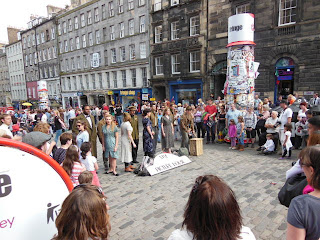The delightful village of Winchcombe, England is on the famous Cotswold Way: 100 miles of paths from Bath to Chipping Camden. During the week we stayed there, we took a couple of walks, the best one being a snippet (5 miles) of the section from Winchcombe to Hailes Abbey.
Leaving the tea room in town center
Up and over "kissing gates and stiles"...Richard still has his eye closed after the kissing.
Navigation was interesting as you leave your GPS behind and follow instructions like these....
"Diagonally cross the field towards a clump of trees, aiming for the left of the trees and over a small knoll down to a stile. Climb the stile, past an ancient oak tree and head straight across the field to a stile. Climb the stile and continue straight on towards a house. Here you will see the Malvern Hills coming into view on your left. Climb the stile and bear right
uphill towards another stile, climb the stile and up to a gate leading onto a lane. Go through the gate and turn left along the lane past St Faith’s Church and Farmcote Herb Garden on your left. Leave the metalled road and follow the track descending slightly with lovely views ahead."
Fortunately you run across signs which help guide you along. I loved the names of the towns:
Spoonley, Guilting Wood, Hinchwick, Ozleworth Bottom, Chipping Norton, Bourton-on-the-Hill,
Milton-under-Wynchwood, Stretton-on-the-Fosse.
This part of the path was pretty unmistakable......
Just after a rain, we picked up quite a load of mud and gunk on the shoes, but it was mostly marvelously green.
We passed by some beautiful English gardens...with sweet peas blooming in late August and
zucchini laid out for passers by to take home.
Leaving the tea room in town center
 | |
You walk down Witches Way...

through fields of grazing sheep, some with lambs.
|
Up and over "kissing gates and stiles"...Richard still has his eye closed after the kissing.
Navigation was interesting as you leave your GPS behind and follow instructions like these....
"Diagonally cross the field towards a clump of trees, aiming for the left of the trees and over a small knoll down to a stile. Climb the stile, past an ancient oak tree and head straight across the field to a stile. Climb the stile and continue straight on towards a house. Here you will see the Malvern Hills coming into view on your left. Climb the stile and bear right
uphill towards another stile, climb the stile and up to a gate leading onto a lane. Go through the gate and turn left along the lane past St Faith’s Church and Farmcote Herb Garden on your left. Leave the metalled road and follow the track descending slightly with lovely views ahead."
Fortunately you run across signs which help guide you along. I loved the names of the towns:
Spoonley, Guilting Wood, Hinchwick, Ozleworth Bottom, Chipping Norton, Bourton-on-the-Hill,
Milton-under-Wynchwood, Stretton-on-the-Fosse.
This part of the path was pretty unmistakable......
 |
We passed by some beautiful English gardens...with sweet peas blooming in late August and
zucchini laid out for passers by to take home.

























